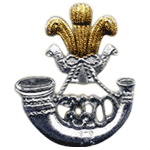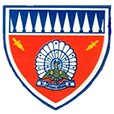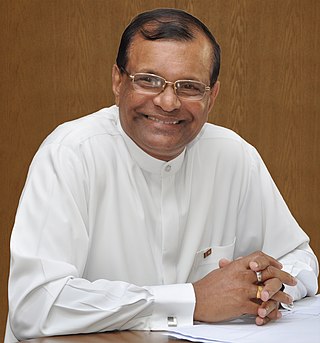The Defence Services Command and Staff College (DSCSC) is situated at Batalanda, Makola (South) 12 Kilometers away from Colombo and its aim to develop the professional knowledge and understanding of experienced officers of the Sri Lanka Army, Sri Lanka Navy & the Sri Lanka Air Force to prepare them for the ranks of junior field officers in the army and the respective ranks of the Navy and Air force. The DSCSC was formerly known as the Sri Lanka Army Command and Staff College (ACSC).

The Sri Lanka Artillery (SLA) is the artillery arm of the Sri Lanka Army. It is made up of ten regular regiments and two volunteer regiments. The SLA is headquartered at Panagoda Cantonment, Panagoda.
The Corp of Sri Lanka Engineers (SLE) is a combat support arm of the Sri Lanka Army which provides military engineering. It is made up of ten regular regiments and one volunteer regiment. Headquartered at Panagoda Cantonment, it is headed by the Centre Commandant.
The Sri Lanka Signals Corps (SLSC) is a combat support corps of the Sri Lanka Army, responsible for providing military communications, information technology and electronic warfare support. The corps is made up of a signals brigade, ten regular regiments and one volunteer regiment. It is responsible for installing, maintaining and operating all types of telecommunications equipment and information systems. It is headquartered at the Panagoda Cantonment.

The Sri Lanka Light Infantry (SLLI) is the oldest regiment in the Sri Lanka Army and the oldest infantry regiment in the army. It is made up of sixteen regular battalions and nine volunteer battalions, and is headquartered at the Panagoda Cantonment, Panagoda.

The Sri Lanka Sinha Regiment (SLSR) is an infantry regiment of the Sri Lanka Army; it is the second oldest infantry regiment in the army.

The Gajaba Regiment (GR) is an elite infantry regiment of the Sri Lankan Army. Formed on 14 October 1983 at the Saliyapura Camp in Anuradhapura, it is named after the famous Sinhalese King Gajabahu the First. It consists of 14 regular battalions and 6 volunteer battalions.

The Gemunu Watch (GW) ("King Dutugemunu's Own") is a infantry regiment of the Sri Lanka Army, formed with troops from the Ceylon Light Infantry and the Ceylon Sinha Regiment in 1962. It has been deployed in many major operations against the LTTE. It is made up of 14 regular units and 9 volunteer units. Headquartered at Kuruwita Army Camp, Ratnapura. It is named after one of the most famous Lankan Kings, King Dutugemunu.

General Jagath Jayasuriya, VSV, USP is a retired Sri Lanka Army officer; he was the Commander of the Sri Lanka Army from 15 July 2009 to 31 July 2013. During the closing stages of the Sri Lankan Civil War, he served as the Commander Security Forces Headquarters - Wanni with overall command of SLA offensives in the Wanni region during the 2008 - 2009 period. He was also the Sri Lankan Ambassador to Brazil, Argentina, Chile, Colombia, Peru and Suriname from June 2014 to August 2017.
Major General Nandana Udawatta, RSP, USP, psc, SLAC was a Sri Lankan general. He has served as the Master General Ordnance, Commander Security Forces Headquarters - Jaffna, Commander Security Forces Headquarters - Mullaittivu and was the general officer commanding, 59 Division during the SLA offensives in the Wanni region during 2008 - 2009 period that led to a major victory for the SLA over the Liberation Tigers of Tamil Eelam (LTTE) in the Sri Lankan civil war.

Major General Gammanpila Arachchige Chandrasiri, RWP, USP, ndc, psc, SLAC was a Sri Lankan senior army officer and a provincial governor. He is the Governor of Northern Province. He was the former Commander Security Forces Headquarters - Jaffna ; General Officer Commanding, 52 Division;, Director General - General Staff, Joint Operations Headquarters; Brigade Commander Armoured Brigade, and Commander, Area Headquarters Mannar.
Major General M.C. Mendaka. P. Samarasinghe, RWP, RSP, USP, ndc, psc, SLE was a Sri Lankan general, he was a former Chief of Staff, Sri Lanka Army and also the former Commander Security Forces Headquarters - Jaffna; he was also the General Officer Commanding, 22 Division.
General Shantha H.S. Kottegoda, WWV, RWP, RSP, VSV, USP is a retired senior Sri Lanka Army officer. He was the seventeenth commander of the Sri Lankan Army from 1 July 2004 – 5 December 2005. He had served as the Sri Lankan Ambassador to Brazil and Thailand. In April 2019, following the Easter Sunday bombings he was appointed as the permanent secretary to the Ministry of Defence.
Major General C.H. Fernando, VSV was a Sri Lanka Army general, who was the former Director of Operations, General Staff; GOC, 2 Division; Commander, Northern Command.
Major General Devinda Kalupahana, RSP, USP, psc, SLAC was a Sri Lankan army general, who was the former GOC, 3 Division; GOC, 2 Division; Director Operations, General Staff and Commandant, Sri Lanka Military Academy.

Brigadier Rohan M. Jayasinghe, USP, psc, SLAC was a Sri Lankan military officer, former Director Armour; brigade commander, armored brigade; brigade commander, 212 Brigade and Sri Lanka's first Defence,Military, Naval and Air attaché, Sri Lankan Embassy, Washington DC.
Major General Y. Balaretnarajah, VSV, USP, ndc is a retired Sri Lankan army officer. He had served as Chief of Staff of the Sri Lanka Army, Commandant of the Volunteer Force and Commander - Jaffna Security Forces. He has commanded the 1 Division, Armoured Brigade, 21 Brigade and 24 Brigade.
Security Forces Headquarters – Central (SFHQ-C) is a regional command of the Sri Lanka Army, that is responsible for the operational deployment and command all army units stationed in the Central and Southern parts of the island, this includes two divisions. The current Commander SFHQ-C is Major General M K S Silva RWP RSP ndu. The SFHQ-C is based at the Diyatalawa Garrison.
Commandant Sri Lanka Army Volunteer Force (SLAVF) has been the title of the head of the Sri Lanka Army Volunteer Force. The post is held by a regular officer of the rank of major general and is the fourth senior position in the army. Commandant is in charge of the Volunteer Force Headquarters and is assisted by a deputy commandant.
Major General Gamini Hettiarachchi, WWV, RWP, RSP, VSV, USP is a retired Sri Lankan Army officer who served as the Commander, Security Forces Headquarters – East, General Officer Commanding, 21 Division and Brigade Commander, Special Forces Brigade. Having founded the Special Forces Regiment of the Sri Lankan Army, he is known as the "Father of the Special Forces Regiment".















